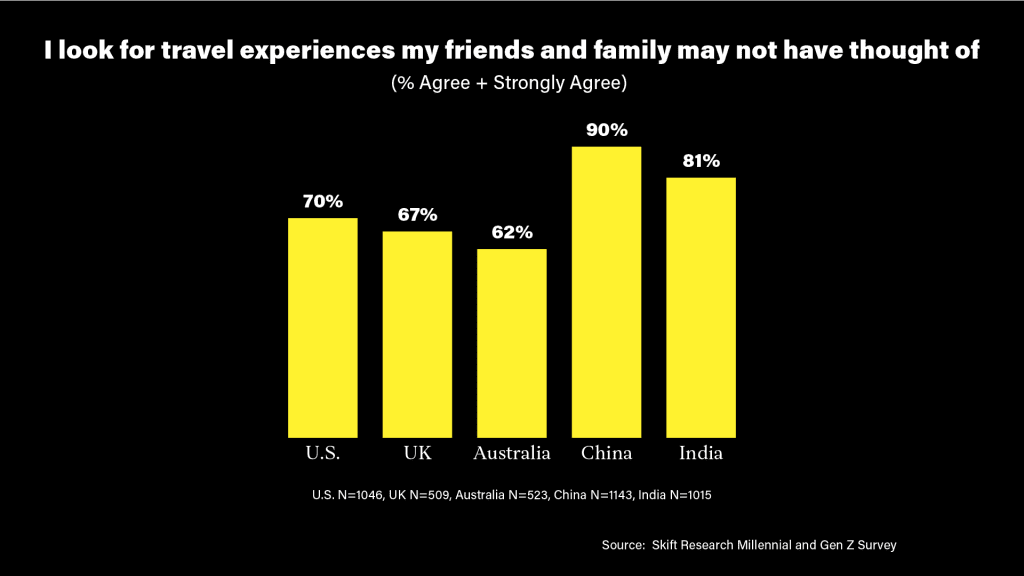The Anywhere Traveler Puts New Destinations on the Map

Skift Take
OK, millennial, goodbye, boomer? One of the biggest shifts of the pandemic snuck under our noses as we hit play on the next episode of Tiger King. It became official in early 2020: millennials overtook the baby boomers as the largest generation in the United States.
There are now 72 million millennials in the U.S. and nearly 1.8 billion worldwide, a quarter of the global population. And while you may still picture that youngster in your office, in truth the typical millennial, born after 1981 and before 1996, is now 34.
At a mid-stage in their careers, millennials are approaching peak purchasing power. Boston Consulting Group estimates that this generational cohort will increase their per capita spending by 10 percent over the next five years. Gen Z per capita spending will rise by more than 70 percent over the same time frame while gen x and boomer spending will shrink.
It's a well-established trend that millennials prefer experience over things. But a less well-understood corollary is that not just any experience will do. In a world where travel is more commonplace than ever, millennials want to be seen as not simply following the crowd but trailblazing unique experiences. Seventy percent of American millennials and gen Zs report seeking out travel experiences that their family and friends have not heard of, according to Skift Research. In China, that figure reaches 90 percent.

There was already a strong brew coming together here: one part rising wealth combined a desire for distinctive travel. The pandemic added the cherry on top. Remote work introduced unprecedented flexibility and made the digital nomad dream seem within reach. Stir well and you get the “anywhere traveler,” a mid-career aspiring jetsetter with the wealth and time to travel nearly anywhere but discriminating enough to not visit just anywhere. This group has a strong passion for experiences that takes them off the traditional travel pathways to less obvious destinations.
Businesses and destinations are already working to cash in on this new trend. Perhaps the brashest is Selina, the hostel turned co-living accommodation brand. Selina calls itself the “largest lifestyle and experience hotel business built to address the desires of millennial and gen Z brands.”
Selina has opened or plans to open 163 properties in 25 different countries to capitalize on these travelers’ nomadic dreams. In addition to traditional daily room pricing, the company offers a month-to-month package that lets guests stay in three different Selina properties within the same region over the course of 30 days. Upgrades to the base plan allow greater flexibility. The average cost of a subscription is roughly $1,000 per month and Selina has sold more than 5,400 subscriptions since the program’s launch in September 2020.
Sam Khazary, executive vice president and head of corporate development at Selina, said that his businesses' subscription members are “helping to fill an occupancy gap.” It’s an important distinction: a long-term subscription member may not spend any more per day than a regular guest and in fact may spend less. But Khazary told Skift that whereas their typical leisure length of stay is three to four days, Colive subscribers stay 55 days on average. In other words, Selina is trading a discount on room rates in exchange for a boost in property utilization.
Skift Research estimates that there are 3.7 million American who have the theoretical ability to choose to become digital nomads. While not all will, if even a small fraction of this population become nomadic the impact could be huge. All considered, Skift Research estimates an addressable market of $972 million a year in travel spend could be generated by U.S. digital nomads.
With such big dollars at stake, it’s not surprising that destinations are interested. Skift reports that dozens of destinations are targeting nomads with perks such as payments to relocate and exemptions from local income taxes. Indonesia, home to nomad super-hub Bali, is considering a special five-year visa while Italy has invested more than $1 billion in infrastructure for small towns to attract nomadic travelers.
Digital nomads will remain a niche market but create an aspirational halo around the idea of living and working in places not yet discovered – and therefore not yet instagramed – by mass tourism.
Digital nomads are the vanguard of the anywhere traveler but behind them come many more millennial and Gen Z tourists. This generation desires for unique experiences and the social credit that comes from being the trailblazer of their social group. Destinations and businesses that can tap into this megatrend are well positioned to succeed.




